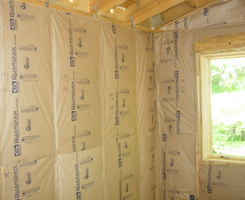Tennessee - Green Cabins at David Crockett State Park Case Study
National Information
Region 4 Toolkits
Historic Preservation and Green Building
Green Building Standards, Certifications, Model Codes and Ordinances
- American Society of Heating, Refrigerating and Air-Conditioning Engineers (ASHRAE 90.1)

- Green Advantage-credential program for construction personnel

- Green Footstep - Rocky Mt. Institute

- Green Globe for Buildings

- Green Seal

- International Green Construction Code

- US Green Building Council-Leadership in Energy and Environmental Design

Professional and Trade Associations
Sustainable Design and Green Building Guides and Products
- CDC Tips for a Green Home
- DSIRE: Database of state incentives for renewables and efficiency

- EPA Green Power Locator
- Forest Stewardship Council

- Green2Green - compare green building products

- International Living Future Institute

- National Resources Defense Council - Building Green

- Savannah College of Art and Design Emergent Structures Initiatives

- Sustainable Facilities Tool

- Sustainable Sites Initiative

- Whole Building Design Guide

Contact Information
Pollution Prevention and Innovation Team
U.S. EPA Region 4
r4sustainability@epa.gov
Background
The Tennessee State Parks system initiated a plan to incorporate more environmentally
efficient and responsible buildings. At David Crockett State Park in Lawrenceburg,
Tennessee, seven new green cabins were unveiled on June 7th, 2010. These are the first
LEED certified vacation villas in any state park system.
The seven cabins ![]() are LEED Silver certified, 80% self-sustainable, and available for rent to the public.
are LEED Silver certified, 80% self-sustainable, and available for rent to the public.
Project Approach and Process
The cabins were built on Lake Lindsey with minimal disturbance to the surrounding environment. Geothermal heating and cooling was used because it not only conserves energy and saves money, but also reduces noise pollution in the park. The construction process used 15-20% less timber framing than usual -- saving trees and the energy needed to harvest and transport additional timber.
Structural green features include:
- concrete baseboard that requires minimal repair/replacement,
- cork flooring,
- recycled plastic decking, and
- exterior siding made of concrete and recycled coal ash.
Water usage is reduced by using:
- native drought-tolerant plants,
- pervious concrete combined with rain gardens to collect and manage stormwater, and
- low-flow plumbing fixtures.
Energy was conserved by:
- reducing leaks,
- taking advantage of natural lighting, and
- installing ENERGY STAR appliances, windows, and lighting fixtures.
Indoor air quality was maintained by:
- utilizing Radon Restraint New Construction methods and
- paints containing low amounts of Volatile Organic Compounds.

Insulation

New cabins at David Crockett are unique modern accommodations with energy efficient and environmentally responsible facilities.
Benefits |
| The cabins not only provide revenue for the Tennessee State Park system, but also educate visitors on green building and energy efficiency. Local schools use the cabins as an example of environmental awareness during field trips to the park. The government’s goal in creating these green cabins was to minimize environmental disturbance while promoting the importance of conserving natural resources to the public. |
Contact Info
Ken NafeKen.Nafe@Tn.gov
![[logo] US EPA](../gif/logo_epaseal.gif)